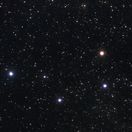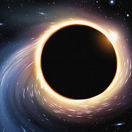Scientists believe they have discovered the closest black hole to date, about 18,000 light-years from Earth, a new study reports.
The study by the Munich-based Max Planck Institute for Astronomy (MPIA) was based on more than 20 years of observations by the Hubble Space Telescope. It was published in the journal Nature, led by Maximilian Haberle from the MPIA.
Scientists studied the Omega Centauri star cluster, made up of approximately ten million stars, visible as a smudge in the night sky south of the equator. According to the scientists, the study confirmed that, although at first glance it does not differ from similar clusters, in fact, at a distance of about 18,000 light years from Earth, it hides a central black hole, which is currently in a transitional stage of development, therefore it is significantly smaller than typical black holes in centers of galaxies.
Scientists say the discovery appears to be the missing link between stellar and supermassive black holes.
MPIA’s Dr. Nadine Neumayer said that at a distance of about 18,000 light years, this is the closest known example of a massive black hole. The better-known supermassive black hole Sagittarius A* at the center of the Milky Way is located approximately 27,000 light-years away.
So far, black holes of various sizes have been recorded. The mass of stars is approximately five to 150 times the mass of the Sun, the mass of supermassive black holes exceeds 100,000 times its mass.

So far, however, only a few black holes have been discovered with an average mass between 150 and 100,000 times the mass of the Sun.
A current study suggests that the Omega Centauri star cluster is the nucleus of a small, independent galaxy whose development was interrupted by the Milky Way’s absorption.

The authors of the study’s accompanying paper, Daryl Haggard and Adrienne Cool, believe that these newly discovered stars offer the best evidence yet for the presence of an intermediate-mass black hole in the Omega Centauri cluster.
According to the scientists, these new findings confirm the validity of the search for medium-mass black holes in other globular clusters.
Source: vat.pravda.sk


